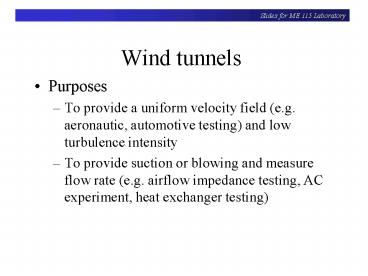Wind tunnels - PowerPoint PPT Presentation
1 / 6
Title:
Wind tunnels
Description:
... uniform velocity field (e.g. aeronautic, automotive testing) and low turbulence intensity ... Flow straighteners (honeycomb) and screens used to straighten ... – PowerPoint PPT presentation
Number of Views:82
Avg rating:3.0/5.0
Title: Wind tunnels
1
Wind tunnels
- Purposes
- To provide a uniform velocity field (e.g.
aeronautic, automotive testing) and low
turbulence intensity - To provide suction or blowing and measure flow
rate (e.g. airflow impedance testing, AC
experiment, heat exchanger testing)
2
Wind Tunnel Design
- Proper shape of the inlet is important several
journal papers offer guidance. - Flow straighteners (honeycomb) and screens used
to straighten flow and provide minimal turbulence
intensity. - Test section should not be too far downstream
from inlet otherwise boundary layers will be
large for slow flows. - If used, orifice plate or venturi tube must be
design per strict ASME standards.
3
Wind tunnel Examples
blower
Test section Uniform velocity
Inlet Designed for uniform inlet flow and
minimal boundary layer formation
Wind tunnel and test section model at NASA-Ames
Source Electronic Laboratory Design
4
More Wind tunnels
5
Velocity Measurement
Pitot-static tube
Hot-wire anemometer
Senses stagnation pressure (at tip) and static
pressure (at holes on periphery) Po P can be
measured. Velocity calculated from Bernoullis
equation.
Uses electricity to heat wire connecting two
prongs to a constant temperature. Required
current and/or voltage is calibrated to velocity.
Orifice plates and venturi tubes are often used
as well (discussed during AC experiment).
6
Hot Dog Anemometer
- Using a cylinder of known properties, a
thermocouple, and stopwatch, fluid velocity can
be determined. If a warm cylinder is placed in a
wind tunnel, the faster the air flows around the
cylinder the faster the temperature of the
cylinder changes. - You will use the concepts of transient heat
conduction and convection around a cylinder in
this lab to calculate the air temperature. - In the past, a hot dog was used as the warm
cylinder. However, a thermocouple must be placed
right in the center, and its tough to make sure
of that with a hot dog, so a plastic cylinder is
now used.































